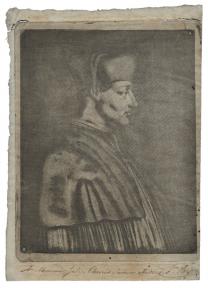« This is but an imperfect trial, but with much patience and work we can do great things. »
Nicéphore Niépce, the inventor of photography
With his invention, Nicéphore Niépce dispensed not only with the status of the reproduced work, the image, but also the subject, the simple subject of all man’s creations. Heliography changed everything and since its invention, nothing has ever been the same. The order of things was forever transformed.
What happened after 1816 in the history of representation was nothing but the deposing of the hierarchy of genres. Heliography brought the nature of things back to their measure and at the same time upset them totally: the new status of the object dismissed in favour of multiplication and dissemination. But paradoxically, there would no longer be any object without interest. From this point on, everything became clues, proof, and fiction. The invention freed us from the real.
The history of photography has only recently begun to recognise the decisive contribution made by Nicéphore Niépce. In a history of photography that is always riddled with contradictory interests, the fact that he was the first to clearly outline the general principles of photography, meaning « fixing images of objects through the use of light », did not ensure his status as inventor. The sad London episode (1827), his premature death (1833), the official title given to the invention, « incorrectly called » daguerreotype (1839) and the English claim for the discovery made by the Englishman W.H. Fox Talbot (1839-1840), all unfortunately combined to turn history away from the path of equity and gratitude. Nevertheless, Nicéphore Niépce’s work takes an essential place in the history of photography through its anteriority and effectiveness and without him Daguerre would never have been in a position to present his own work to Arago as it was largely consecutive and dependent on their partnership contract (1829-1833).
Nicéphore Niépce’s letters and writings form a space where his proposals spurt out and organise themselves. The thinking might appear confused at times as everything comes together and is transformed in the associated field that Nicéphore Niépce referred to as heliography. The reconstitution of events and the discontinued mode of expression do not reveal the incoherence of his work, on the contrary they reveal how strongly rooted it was in the complexity of the real. The invention of photography is unique in its mode of announcements and statements. The numerous letters in the museum’s possession, the way they emerged, the law of coexistence with other statements, like the treatise on heliography, elaborate the principles that form the basis of the evidence of photography. Nicéphore Niépce was the first to be fascinated by what he glimpsed and succeeded in doing.
The resulting literature swings from the humility of manual work to a fascination for magic. Nicéphore Niépce’s letters validate, legitimise but above all give the object meaning. From one letter to the next, we follow the process, with his questions and doubts, a discourse that interrogates the practice. But above all, the epistolary exchanges prove his conviction, belief and the solid basis for his invention.
Heliographs on metal are not all of the same type. Nicéphore Niépce discovered the virtues of Bitumen of Judea when exposed to light. Based on this principle that owes much to engraving, he developed two potential options, the fixing of the « viewpoint » in the camera obscura
and the reproduction of the engravings.
Certain metallic plates like "La sainte Famille", with their clean, deep cuts, and network of precise chops, were designed to be reproductive models.
Others, such as the plate commonly known as "le joueur", have a less precise drawing that permits no prints after inking. So it must be considered as a simple reproduction and not as a model. In addition, they appeared at a time when Nicéphore Niépce (March 1827), was experiencing one failure after another with his prints from engraved plates.
During the summer of the same year, a crucial year for the invention, Nicéphore Niépce took another path using Bitumen of Judea and obtained images directly from the camera obscura . The photograph « Le point de vue du Gras » is the first example of a finished, fixed image on a photosensitive surface.
In the whole collection of engraved plates, one late image (1828), the plate entitled "couple grec" has a particular place in Niépce’s production. The un-engraved image, - by the way, it holds very little interest -, seems to be placed on the metallic surface. Brass replaced tin and was covered in a thin layer of silver so the image appears positive, the result of inverting the iodine, two principles that precede the daguerreotype by ten years.
So this is the heritage of Nicéphore Niépce, a wide range of methods that go from taking shots using a camera obscura to the little known photogravure process. There is no longer any doubt as to the technical success and effectiveness of the work of Nicéphore Niépce. But it is our job to measure the effect this founding act had in real terms.









